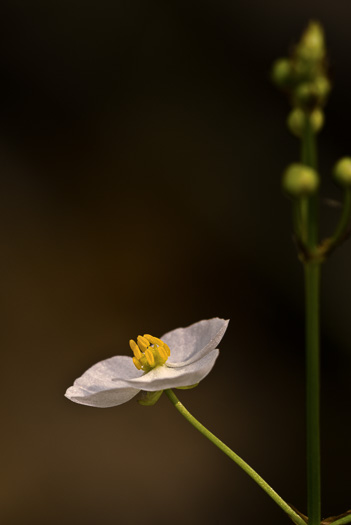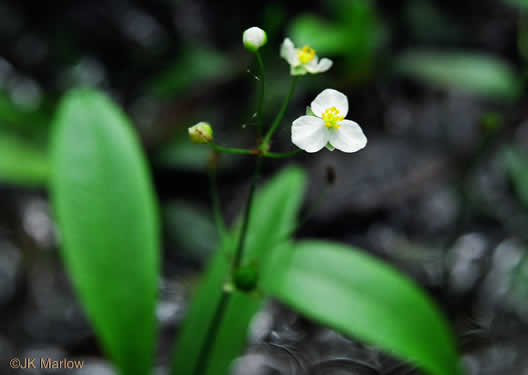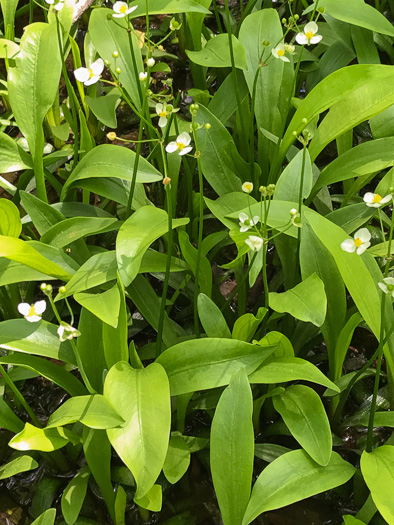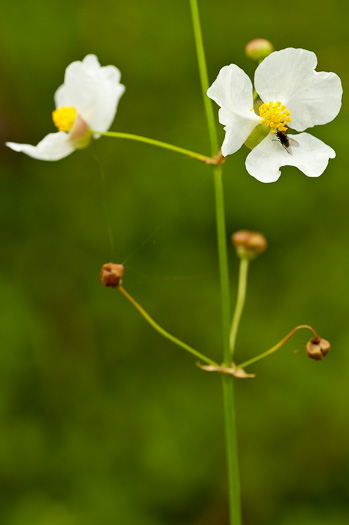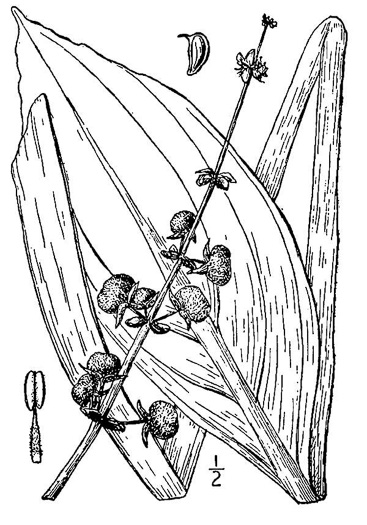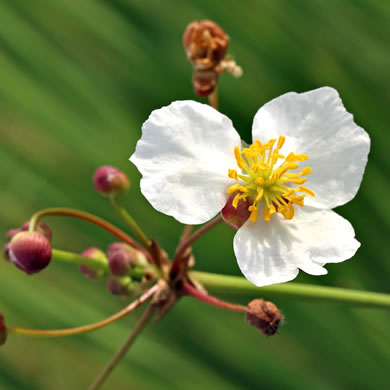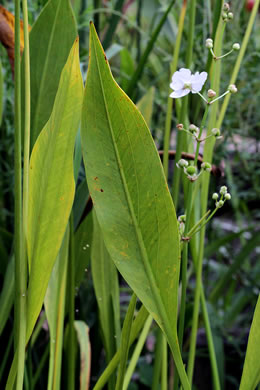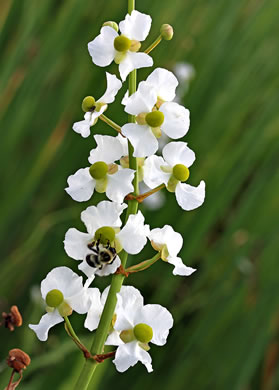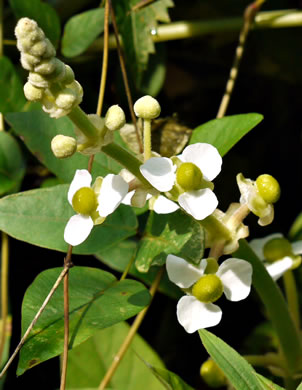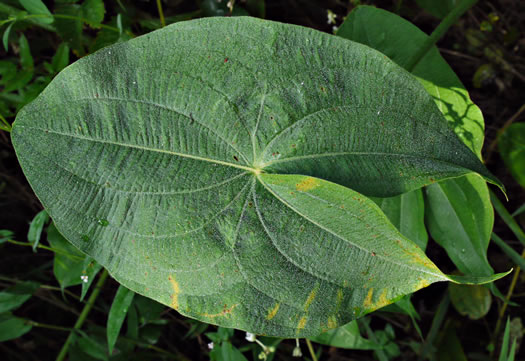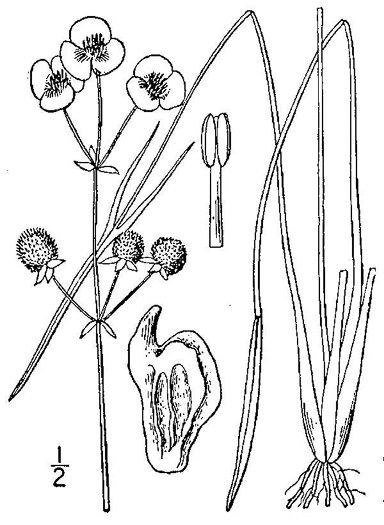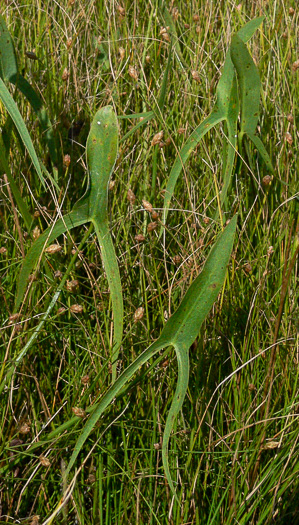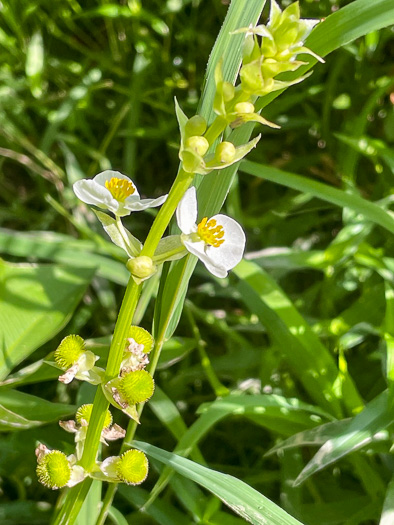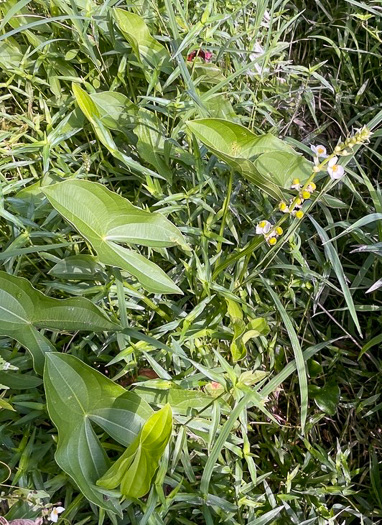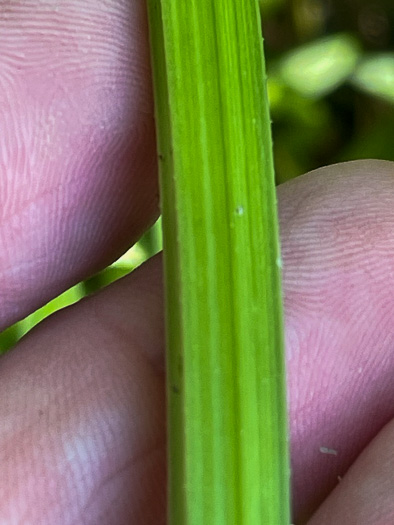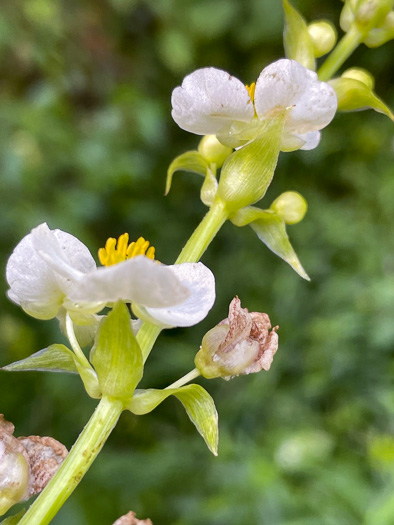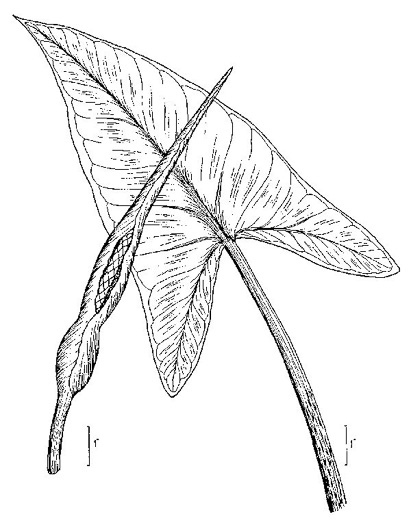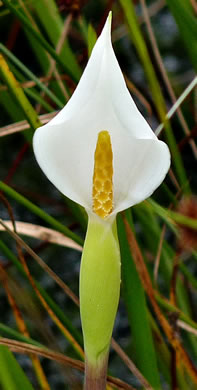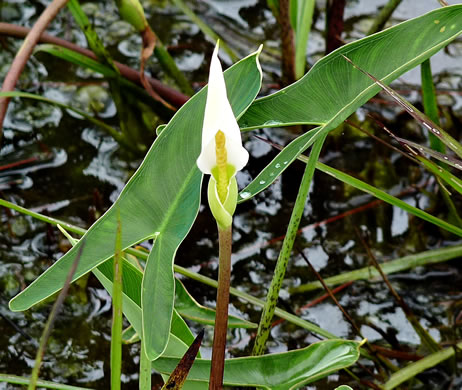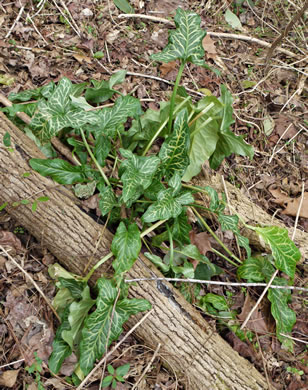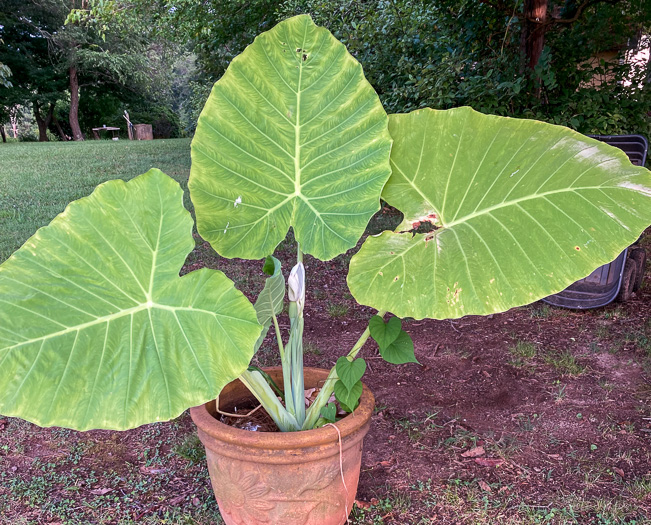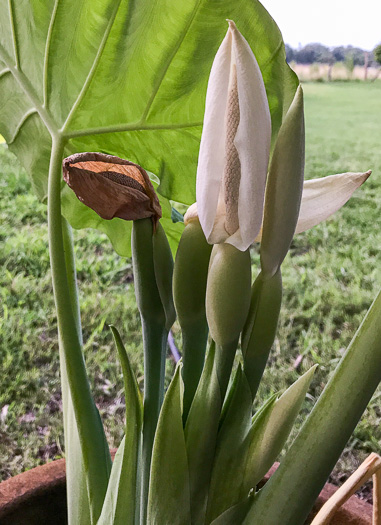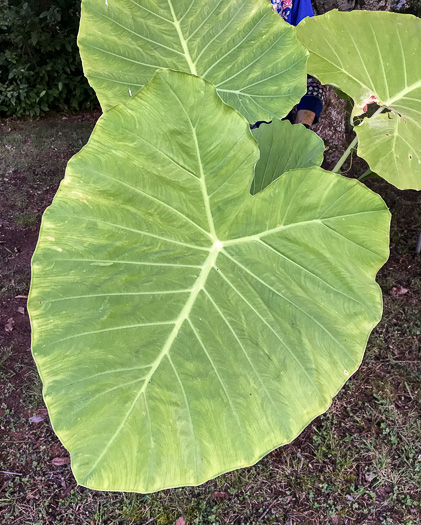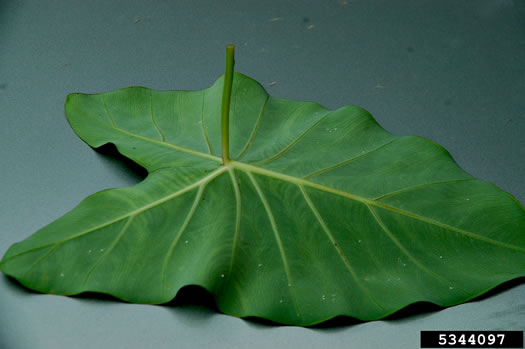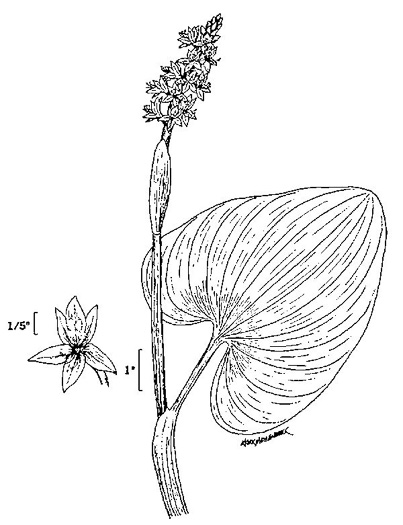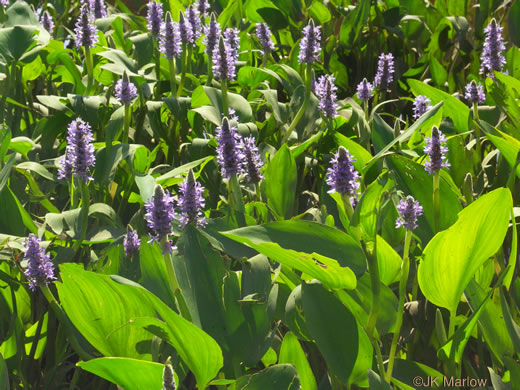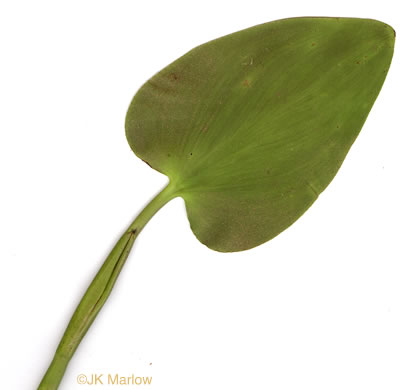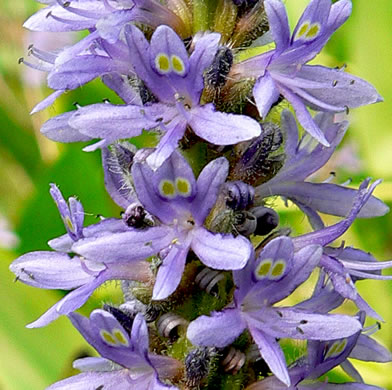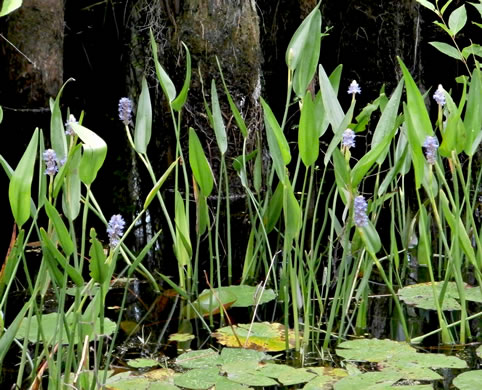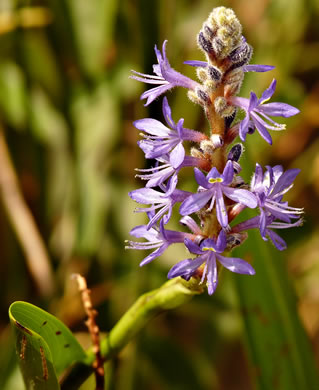Your search found 43 image(s) of Arrowhead, Arum, Elephant's Ear and Pickerelweed.
To see larger pictures, click or hover over the thumbnails.
To go to the plant's detail page, click its name.
 Habitat: Marshes, ponds, freshwater and oligohaline tidal marshes
Habitat: Marshes, ponds, freshwater and oligohaline tidal marshes
Flowers to 2.3 cm diameter; filaments shorter than anthers, per Flora of North America.
 Habitat: Bogs, ditches adjacent to drained bogs, wooded seepage areas
Habitat: Bogs, ditches adjacent to drained bogs, wooded seepage areas
Flowers usually in 2-4 whorls of 3, upper usually staminate, lower pistillate, per Vascular Flora of the Carolinas (Radford, Ahles, & Bell, 1968).
Leaves of this Arrowhead are spatulate, consistently lacking basal lobes, per Wildflowers of the Southern Mountains (Smith, 1998).
Long parallel veins run almost the entire length of the leaf, per Bunched arrowhead.
 Habitat: Marshes, swamps
Habitat: Marshes, swamps
Flowers to 3.3 cm diameter; filaments longer than anthers, per Flora of North America.
 Habitat: Freshwater to brackish (mesohaline) tidal marshes
Habitat: Freshwater to brackish (mesohaline) tidal marshes
Upper flowers are staminate, per Wild Flowers of NC, 2nd edition (Justice, Bell, & Lindsey, 2005).
Leaves lanceolate to broadly ovate, emersed [rising out of the water], per Flora of North America.
Flowers in whorls along the stem, the lower pistillate, per Wild Flowers of NC, 2nd edition (Justice, Bell, & Lindsey, 2005).
 Look for it in bogs, marshes, and - in the case of var. latifolia - swamps, farm ponds, ditches
Look for it in bogs, marshes, and - in the case of var. latifolia - swamps, farm ponds, ditches
Leaves palmately veined; leaf bases with long pointed lobes , per Wildflowers of the Southern Mountains (Smith, 1998).
Showy white flowers with 3 petals, the lower flowers usually female, per Wildflowers & Plant Communities of the Southern Appalachian Mountains and Piedmont (Spira, 2011).
Leaf blades of S. latifolia var. pubescens are rather densely fine-pubescent, per Weakley's Flora (2023).
 Habitat: Blackwater streambanks, sphagnum bogs, pocosins, beaver ponds
Habitat: Blackwater streambanks, sphagnum bogs, pocosins, beaver ponds
Leave typically narrowly sagittate, to 8" long, the lobes less than 1" wide, per Wildflowers of the Sandhills Region (Sorrie, 2011).
Flowers 18-25mm across, in 2-4 whorls, female below, male above, per Wildflowers of the Sandhills Region (Sorrie, 2011).
 Habitat: Marshes, swamps, rivershores, backwaters, margins of ponds and lakes
Habitat: Marshes, swamps, rivershores, backwaters, margins of ponds and lakes
Inflorescence unbranched; bracts of the inflorescence papery, acuminate at the tip, per Weakley's Flora (2023).
Leaves arrowhead-shaped with broad basal lobes, 4-10" long, smooth, per Wildflowers of the Atlantic Southeast (Cotterman, Waitt, & Weakley, 2019).
Petiole sharply 5-wing-angled in cross-section, per Weakley's Flora (2023).
Flowers subtended by bracts that are longer than the pedicels (vs. shorter in S. latifolia), per Wildflowers of the Southern Mountains (Smith, 1998).
 Habitat: Marshes, bogs, beaver ponds, pocosins, other stagnant, aquatic situations, freshwater to oligohaline tidal marshes
Habitat: Marshes, bogs, beaver ponds, pocosins, other stagnant, aquatic situations, freshwater to oligohaline tidal marshes
The tiny flowers grow densely on a yellow cylindrical stalk (spadix), per Wildflowers of the Sandhills Region (Sorrie, 2011).
Foliage suggests that of Sagittaria latifolia, but leaves pinnately veined, per Wildflowers of the Southern Mountains (Smith, 1998).
 Habitat: Pocosins of the outer Coastal Plain, sphagnous swamps. Peaty ecotones between bayheads and seepage slopes (Coleataenia abscissa/Magnolia virginiana bayhead ecotones in c. FL). Typically in wet, mucky, sphagnous, or otherwise deeply saturated soils often with some standing water
Habitat: Pocosins of the outer Coastal Plain, sphagnous swamps. Peaty ecotones between bayheads and seepage slopes (Coleataenia abscissa/Magnolia virginiana bayhead ecotones in c. FL). Typically in wet, mucky, sphagnous, or otherwise deeply saturated soils often with some standing water
Inflorescence a spadix subtended by a flared, open, white spathe, per Guide to the Wildflowers of SC, 1st ed. (Porcher & Rayner, 2001).
Leaf blade smaller on average and less variable in shape than P. virginica, per Flora of North America.
 Habitat: Suburban woodlands, naturalizing from horticultural use
Habitat: Suburban woodlands, naturalizing from horticultural use

Spathe tube green, ellipsoid; limb erect, white, oblong-boat-shaped, distinctly constricted, per Flora of China.
Leaves very large; peltate, base cordate, margin undulate, apex shortly acuminate, per Flora of China.
 Habitat: Ditches, shores, bottomland hardwood forests
Habitat: Ditches, shores, bottomland hardwood forests
Leaves are held on 3' long petioles that attach in the center of the leaf, per Invasive Plants, Guide to Identification, Impacts and Control (Kaufman & Kaufman, 2007).
Leaves shaped like an elephant's ear or a fat arrowhead, 2-3' long, per Invasive Plants, Guide to Identification, Impacts and Control (Kaufman & Kaufman, 2007).
Spathe limb opening only proximally (remainder furled), lanceolate or elliptic, apex acuminate, per Flora of China.
 Habitat: Swamps, seepage areas, marshes, pond-shores, lake-shores
Habitat: Swamps, seepage areas, marshes, pond-shores, lake-shores
Lvs mostly ovate to triangular-lanceolate, base generally cordate or truncate, per Weakley's Flora.
Often in dense colonies, per Wildflowers of Tennessee, the Ohio Valley, and the Southern Appalachians (Horn, Cathcart, Hemmerly, & Duhl, 2005).
Leaves basally sheathing, petiolate, and parallel curved-convergent veined, per Plant Systematics (Simpson, 2010).
Flowers 2-lipped, each lip 3-lobed, the upper lip marked with yellow, per Wildflowers of Tennessee, the Ohio Valley, and the Southern Appalachians (Horn, Cathcart, Hemmerly, & Duhl, 2005).
 Habitat: Marshes, pond-shores, lake-shores
Habitat: Marshes, pond-shores, lake-shores
Found in marshes, pond and lake shores of the Coastal Plain, per Weakley's Flora.
Each plant produces a 5" spike of violet-blue flowers, per Wildflowers of the Southern Mountains (Smith, 1998).
Leaves lanceolate, the base generally cuneate to truncate, per Weakley's Flora (2022).


